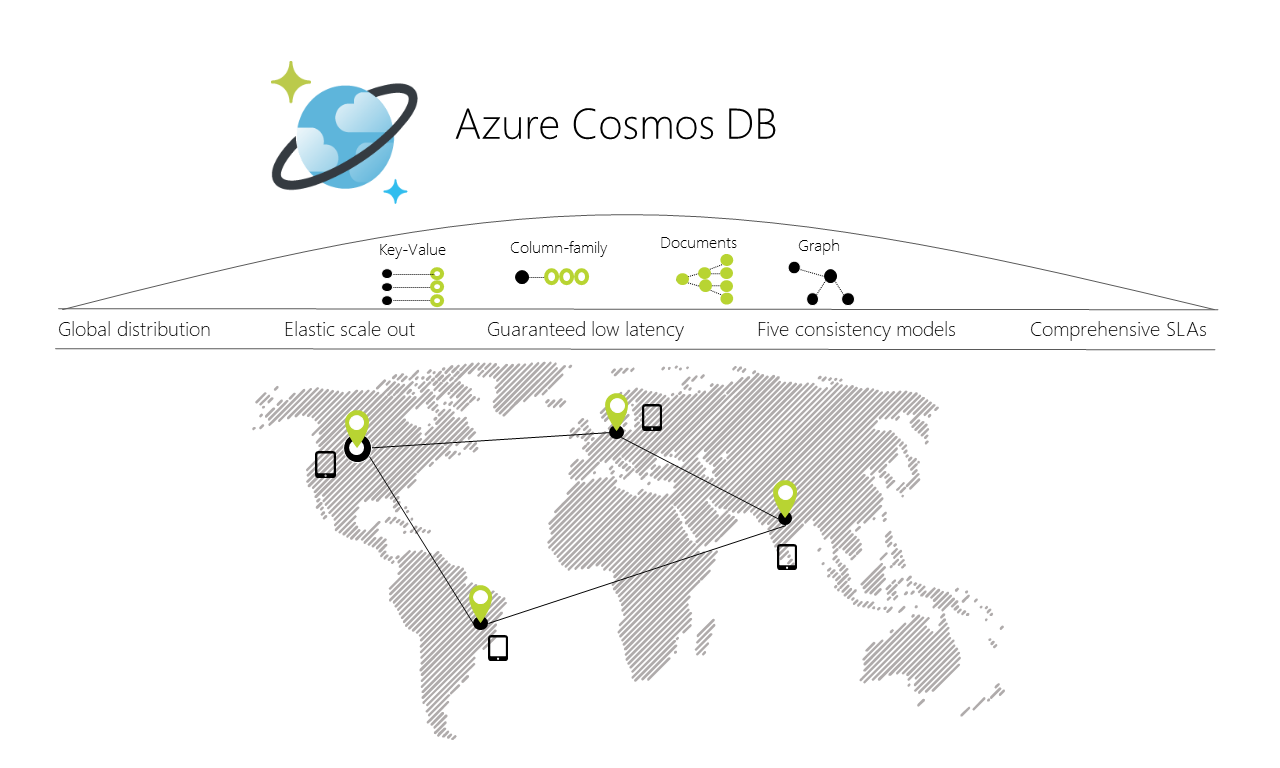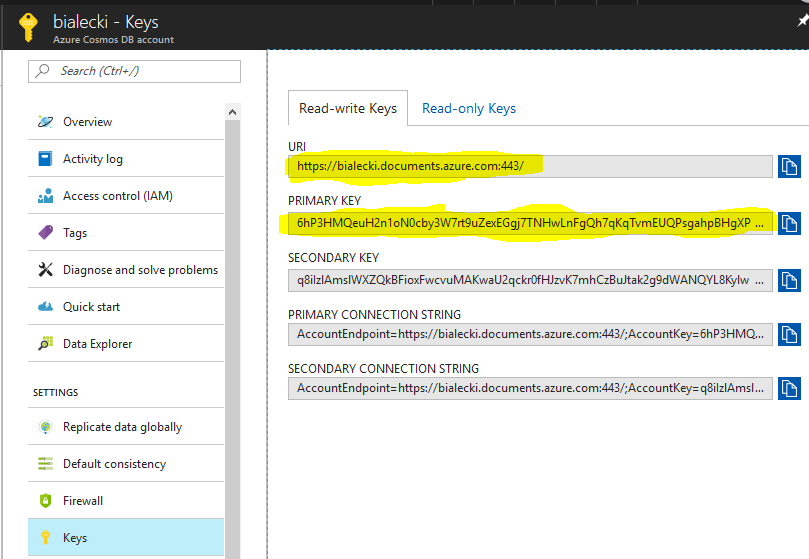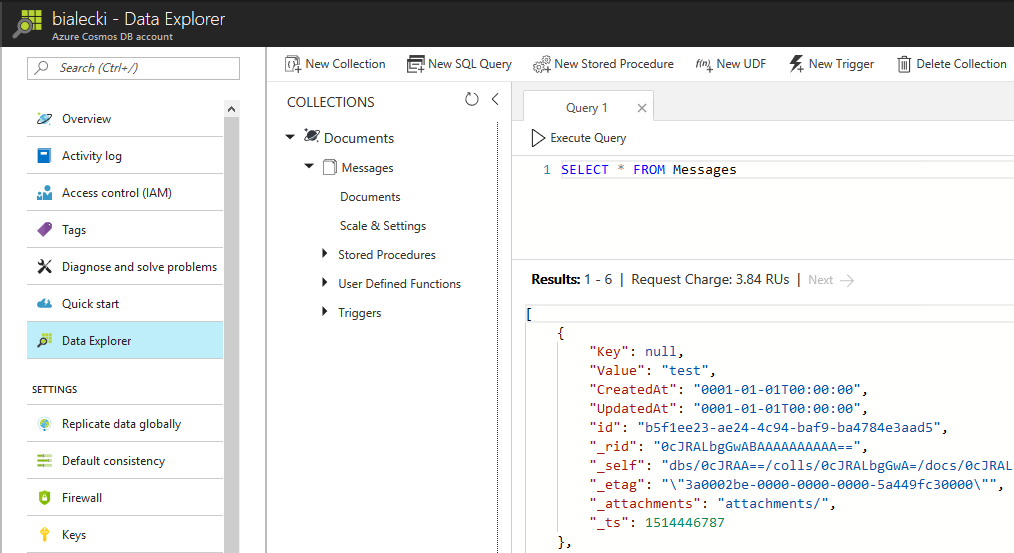CosmosDB is Microsoft’s new way of storing data in the cloud, comparing to good old MSSQL Server. It offers globally distributed, multi-model database. Interesting fact is that it offers multiple model of storing data: key-value, column-family, documents and graph as shown in this picture:

Image from https://docs.microsoft.com/en-us/azure/cosmos-db/media/introduction/
First you need a Cosmos DB account
Create a Cosmos DB account, then go to Keys tab – you will need PrimaryKey and EndpointUri.

Now go to Data Explorer and create a database and collection. I created Documents database and Messages collection.

Connecting to Cosmos DB
I’m developing my app in .NET Core and for that I need to install Microsoft.Azure.DocumentDB.Core nuget package. Then I created a DocumentDbService class, that will connect to application to Cosmos DB api.
public class DocumentDbService
{
private const string DatabaseName = "Documents";
private const string CollectionName = "Messages";
public async Task SaveDocumentAsync(DocumentDto document)
{
try
{
var client = new DocumentClient(new Uri(ConfigurationHelper.GetCosmosDbEndpointUri()), ConfigurationHelper.GetCosmosDbPrimaryKey());
await client.UpsertDocumentAsync(UriFactory.CreateDocumentCollectionUri(DatabaseName, CollectionName), document);
}
catch (Exception e)
{
Console.WriteLine("Error: {0}, Message: {1}", e.Message, e.GetBaseException().Message);
}
}
}
ConfigurationHelper class is just a static class that gets EndpointUri and PrimaryKey as strings, so you can just paste them here directly. The code above will create a new document in Documents database and Messages collection.
DocumentDto is just a simple object that will be saved as json:
public class DocumentDto
{
public string StockId { get; set; }
public string Name { get; set; }
public float Price { get; set; }
public DateTime UpdatedAt { get; set; }
}
In order do use it in ASP.NET Core I created a controller:
public class MessagesController : Controller
{
[HttpPost]
public async Task<IActionResult> Save([FromBody]SendMessageDto message)
{
try
{
var document = new DocumentDto
{
StockId = message.StockId,
Name = message.Name,
Price = message.Price,
UpdatedAt = DateTime.UtcNow
};
await new DocumentDbService().SaveDocumentAsync(document);
return StatusCode(200);
}
catch (Exception e)
{
Console.WriteLine(e);
return StatusCode(500, e.Message);
}
}
}
Usage of it is very simple – it creates DocumentDto and store it in Cosmos DB database. To see the result you need to go to Azure’s Data Explorer and fetch for Messages like in a screen above.
Getting data from Cosmos DB with SQL api
Microsoft’s new storage api has ability to store data in a multiple formats. Let’s try getting the latest updates from Messages collection. In DocumentDbService class we need a part of code to get data:
public IQueryable<DocumentDto> GetLatestDocuments()
{
try
{
var client = new DocumentClient(new Uri(ConfigurationHelper.GetCosmosDbEndpointUri()), ConfigurationHelper.GetCosmosDbPrimaryKey());
return client.CreateDocumentQuery<DocumentDto>(
UriFactory.CreateDocumentCollectionUri(DatabaseName, CollectionName),
"SELECT * FROM Messages ORDER BY Messages.UpdatedAt desc",
new FeedOptions { MaxItemCount = 10 });
}
catch (Exception e)
{
Console.WriteLine("Error: {0}, Message: {1}", e.Message, e.GetBaseException().Message);
return null;
}
}
This is where magic happens. As you can see I used plain old SQL query as it would be Messages table, but instead I queried json objects that does not necessary need to have UpdatedAt field.
Code in the controller is very simple.
[HttpGet]
public IQueryable<DocumentDto> GetTenLatestUpdates()
{
try
{
var documents = new DocumentDbService().GetLatestDocuments();
return documents;
}
catch (Exception e)
{
Console.WriteLine(e);
return null;
}
}
Notice that GetTenLatestUpdates controller method returns IQueryable interface that on web will be presented as json, but there is also a way to efficiently filter data with OData.
Hi,
Will be there next part about performance?
How would you improve performance for large amount of data to retrieve?
Task.WhenAll() does not look the safest way here?
How about writing custom Enumerable and Enumerator to stream a lot of data from CosmosDB?
Using ContinuationToken and deserialize and mapping to DTO.
Best regards